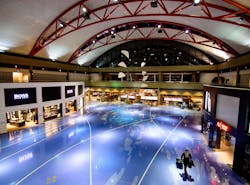For leaders at the Houston Airport System, getting millions of travelers through George Bush Intercontinental Airport (IAH) and William P. Hobby Airport (HOU) each year can be a challenge.
Travelers have to navigate the facilities and find their ways to the gates, which creates a stressful start to a trip and seeds negative connotations about an airport.
In July, Houston launched a wayfinding system within the airports’ websites, so travelers know where they’re going as soon as they park their car.
“We realized that we were really filling a need,” said Kathleen Boyd, head of marketing for the Houston Airport System. “We also had done some research on the hierarchy of needs of passengers where three out of the top 10 items had to do with wayfinding.”
Many airports and airlines use apps to provide wayfinding, but it can be a challenge to get people to download and use them, Boyd said.
“We’ve really been on a mission to come up with website or browser-based wayfinding and we were fortunate enough to meet up with LocusLabs, who was working on the same project,” she said.
The wayfinding allows travelers to find their gate and search restaurants and concessions. An estimated time to reach the destination is also included as part of the system.
Boyd said the airports will utilize different ways to get travelers to engage in the technology using the JC Decaux digital signage to inform travelers about the technology while upgrading other aspects of terminal wayfinding to keep passengers happy.
Build a better experience
Pat Askew, principal and leader of the global aviation practice for HKS, said airports need to take cues from the hospitality industry to deliver a customer-centric model.
“The hospitality industry, especially the higher end you go in the hospitality industry, the more focused they are on the customers,” he said. “Since airports are really part of the travel experience it seems to make sense that hospitality really finds its way into airport terminals and doesn’t just stay in the hotels or the resorts.”
Askew said terminals need to be less institutional and more like a high end hotel. The colors, lighting, natural lighting and building materials can make the terminal feel high end and less like a large bus terminal.
Customer service needs to play just as big of a role in the high end experience, he added, so getting employees on the same mindset from the Transportation Security Administration (TSA) checkpoint, to the shops and restaurants, and the airlines are all important to make sure the travelers have a seamless positive experience with staff.
Technology plays a big part in improving the journey through the facility as well, Askew said. Allowing passengers to access information about their flights and options within the terminal with proper wayfinding creates a positive experience as someone makes their way to the gate.
Creating alerts for passengers at the airports about special deals on food or sales sent to their phones provide more access to information. Sending information to their phones about when and where baggage will arrive can also improve the experience by taking away anxiousness from passengers.
“We’re all passengers at some point so think about what makes us anxious? What makes us frustrated and what are the sources of our bad experiences or where do we know where things could have been better only if someone had thought of this or thought of that,” Askew said. “A lot of it is applying technology to get information to people and to let them know so they don’t worry about it.”
Askew said one of the problems with airports is how they positioned concessions and eateries in the past. Things were relegated to specific lease areas of the terminal, so they went where they could as opposed to where they should. Airports have a lot more flexibility with their lease lines and can allow for more integration of shops and restaurants with the gate hold areas, creating a much more lounge-like atmosphere for passenger.
“It allows things to be more flexible and to put the dining area right by where people are waiting for their plane, not unlike what happens in an airline club where you’re not just sitting and waiting for your plane, but you can get something to eat, you can get something to drink and it’s all very easy and very convenient,” he said. “I think that idea has really found its place in the general public areas of hold rooms.”
Askew said airlines are recognizing the benefit of airports making more money off the customers and making them happier as it takes more of the burden off them.
“I think the business of airports is greatly maturing where it’s not all just divided up into leaseholds,” he said.
Making improvements to the terminal for a better passenger experience doesn’t have to be a massive investment for airports. Askew said things like furniture are a depreciable asset can make a huge visual improvement while enhancing the atmosphere; lighting changes can remove harsh light inside the terminal at night; signage upgrade improves wayfinding and information; play areas provide sanctuary for children; and even adjustments to the PA system can create a better environment.
Askew said before making a plan to make your terminal a better place, airport leaders need to recognize things need improvement and what it will take explore different ideas to meet their goals.“What we or any other good architect is about, we’re not there to make a design statement. We’re there to make things better for the people who use the space,” he said. “It’s really up to the airport or the airline to recognize that they need or should make an improvement and be able to stick with it and realize it’s not something as just as simple as changing some light bulbs or throwing some paint down to make things better.”
A shift in taste
Airports need to keep a keen eye on the concessions offerings they have as well, with a major generational shift coming to the demographics of those traveling.
Ben Zandi, president and CEO of Fraport USA, said by 2020 more than 50 percent of the U.S. population will be millennials, Generation Y and Generation X, meaning there will be a shift in demands. These travelers are concerned about price in aviation, they’re health-conscious, they have allergies, they have the same demands they have on the streets in the airport environment, they want to taste and experience the local culture and technology is extremely important to them, with 60 percent of their purchases coming via technology.
Fraport worked with Grab to develop a directory for airport concession options. The company is looking to push the concept out globally.
“They prefer transactions to be quick, convenient and with integrity,” Zandi said. “And they have a very particular pallet. They know what they want and convenience is very important to them.”
To address this growing need, Zandi said Fraport is working with local restaurants in the communities connected to the airport and finding ways to draw them into the concessions for travelers. This includes looking at popup shop concepts in the terminal.
“On our side, we’re repositioning our brand to be able to match this generation shift, so therefore we’re much more conscious to our commitment to each airport,” he said. “Currently, we’re committed to a minimum of 35 percent of our commercial space to be local business owners and to bring in the local culture of the city to the airport.
“My goal is by 2020, my commitment moves 40 percent for all our properties to be regional/local in the retail food and beverage.”
Zandi said the generational shift in travelers also is bringing demand from travelers for humanity in pricing, so they’re working to honor street pricing whenever possible. Some airports enforce an additional increase in concession prices, but some don’t have any restrictions.
A popup program can be very economically friendly to local operators, from an investment and income perspective, Zandi said. Fraport implemented a popup program for retail at Baltimore/Washington International Thurgood Marshall Airport (BWI), which has been very successful, so they’re looking at a similar program for food and beverage.
Cleveland Hopkins International Airport (CLE) will also get a popup program by the end of 2017.
“As you can see, the trend around the country with food trucks in metropolitan cities has taken off because economically it makes sense for the owner/operator,” Zandi said. “We’re trying to bring the same concept to the airports.”
Keep Technology in mind
Ron Gazzola, senior vice president for commercial display, Samsung Electronics America, said digital signage remains a strong option for airports to enhance the passenger experience. A broader offering of products for outdoor usage and LED technology are helping drive that growth as industries can now use the technology in new ways to serve customers, including airports.
“The technology, it really allows the designers, the IT team to come together and think very differently about how they can use space, what they can use that space for when traditionally it might have been just pure advertising,” he said. “They can use it to think a little bit differently about not only advertising, but information, safety and improving the overall experience as one goes through the airport.”
One of the big areas of interest Samsung is seeing in this area is moving from large video walls to LED technology. It allows airports to place signage in new areas and build another revenue stream.
“LED technology is much brighter technology, customizable with regard to size, eliminating all of the bezels and seams that you’d see in an old video wall display,” he said. “The reason we’re seeing this be more relevant is we’re at a point that the technology is very advantageous for people wanting to invest and it’s also giving the airports a huge opportunity in terms of advertising revenues.”
Gazzola said there’s also a lot of interest from airports now in upgrading outdoor signage. More rugged technology can create opportunities to place signage in areas like parking garages, rental car facilities or baggage claim areas can enhance the passenger experience in those areas.
Samsung is even working with Hertz on a program to deploy outdoor signage for their gold member customers to create a custom meet and greet when they arrive, Gazzola said.
“Someone going to park their car, outdoor signage is going to create a more convenient way for those customers to get information and access information. In terms of back-end operation for the different airlines or baggage through using outdoor technology and outdoor digital signage is another way we’re seeing screens implemented into those types of work streams,” he said.
Digital signage also allows for endpoints when it comes to beacon and GPS deployments in airports, Gazzola said, where travelers can use mobile devices to interact with the signage and more personalized information.
Moving to digital signage gives brightness and information for passengers and Gazzola said it also gives control to the airport to change that messaging dynamically.
“Those signs and the content that’s on those digital signs can be controlled,” he said. “You may have advertising on there from peak travel times and then you might want to use it for some other sort of content. You may have that hooked to a central system where there’s some kind of emergency on all of the digital signage network and emergency information needs to be broadcast.
Where concessions and technology meet
Bryan Meszaros, CEO & founder of OpenEye Global, said airport continue to evolve into more complex places full of amenities to enhance the passenger experience, but most travelers are unaware of many of the services available to them, so a proper wayfinding system can educate them.
There are different options in airports now to address these issues, but a lot of them don’t address all of the amenities or deliver up-to-date information, so technology plays a key role in educating airport users.
It becomes a challenge in simplifying the wayfinding because static signage or placing a monitor displaying basic information isn’t going to work for everyone, Meszaros said.
“I think they’re realizing that you can’t go down a very simple route because you really have to take into consideration who is the traveler? What’s the demographic of the traveler because it’s very different for everyone” he said. “Everyone has their own different expectations, so you have to develop a system that can accommodate that and secondly one that’s designed to align with the amount of time that traveler has.”
Tomer Mann, senior vice president of global sales and operations for 22Miles, said it’s also key airports allow for the information to be taken by travelers via a mobile device, such as texting directions to the right concessions, a QR code or email, or even a full mobile app giving them visuals in order to simplify the passenger experience.
Meszaros said the company has done work with Westfield at Boston Logan International Airport (BOS) and John F. Kennedy International Airport (JFK) to provide an intuitive wayfinding experience. Passengers could approach a kiosk and use their boarding pass to initialize the experience so they can see their gate and the amenities near them.
“In a manner of seconds, they know where they’re going and they’ve already been able to identify places they can go to eat or to enjoy or relax,” he said.
It also involved machine learning so officials could monitor what was popular with travelers and trends to help similar customers. It starts creating the preferences based on recommendations based on the criteria, Mann said, so recommendations could be customized to solo travelers, families, business travelers, those with little time or those with extra time.
“It starts tracking with data analytics where people are going, what they’re preferring, so not only does it benefit the traveler, it also benefits the terminal,” Mann said. “Westfield is now able to produce some ROI and see what the popular locations people are going to.”






